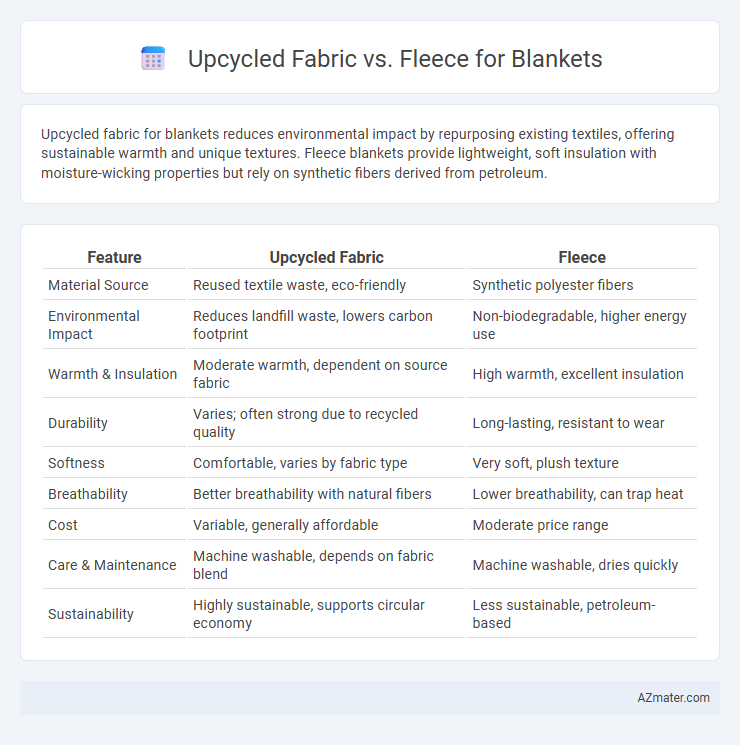Upcycled fabric for blankets reduces environmental impact by repurposing existing textiles, offering sustainable warmth and unique textures. Fleece blankets provide lightweight, soft insulation with moisture-wicking properties but rely on synthetic fibers derived from petroleum.
Table of Comparison
| Feature | Upcycled Fabric | Fleece |
|---|---|---|
| Material Source | Reused textile waste, eco-friendly | Synthetic polyester fibers |
| Environmental Impact | Reduces landfill waste, lowers carbon footprint | Non-biodegradable, higher energy use |
| Warmth & Insulation | Moderate warmth, dependent on source fabric | High warmth, excellent insulation |
| Durability | Varies; often strong due to recycled quality | Long-lasting, resistant to wear |
| Softness | Comfortable, varies by fabric type | Very soft, plush texture |
| Breathability | Better breathability with natural fibers | Lower breathability, can trap heat |
| Cost | Variable, generally affordable | Moderate price range |
| Care & Maintenance | Machine washable, depends on fabric blend | Machine washable, dries quickly |
| Sustainability | Highly sustainable, supports circular economy | Less sustainable, petroleum-based |
Introduction to Upcycled Fabric and Fleece
Upcycled fabric is crafted from reclaimed textiles, reducing waste and promoting sustainable production by transforming old materials into new, usable blankets. Fleece, typically made from synthetic fibers like polyester, offers lightweight warmth and moisture-wicking properties but relies on non-renewable resources. Comparing these materials highlights the environmental benefits of upcycled fabric against the insulation performance and durability of fleece blankets.
Environmental Impact: Upcycled Fabric vs Fleece
Upcycled fabric significantly reduces environmental impact by repurposing existing materials, minimizing waste and conserving resources compared to fleece, which is typically made from petroleum-based synthetic fibers contributing to microplastic pollution and higher carbon emissions. The production of fleece involves energy-intensive processes and chemical treatments, whereas upcycled fabric leverages already manufactured textiles, lowering overall ecological footprint. Choosing blankets made from upcycled fabric supports circular economy principles, helping to reduce landfill waste and decrease the demand for virgin raw materials.
Material Sources and Production Processes
Upcycled fabric blankets utilize reclaimed textiles from pre-existing garments or factory scraps, significantly reducing waste and environmental impact by repurposing materials that would otherwise be discarded. Fleece blankets are primarily made from synthetic fibers, such as polyester derived from petroleum, produced through an energy-intensive process involving polymerization and knitting or weaving techniques. The sustainable advantage of upcycled fabric lies in its circular production model, whereas fleece production contributes to microplastic pollution despite its durability and insulation properties.
Warmth and Insulation Comparison
Upcycled fabric blankets often vary in warmth depending on the original material but generally provide moderate insulation with an eco-friendly advantage, as they reuse fibers and reduce waste. Fleece blankets, typically made from synthetic polyester, offer superior insulation and moisture-wicking properties, making them exceptionally warm and lightweight for cold conditions. When comparing warmth and insulation, fleece excels in retaining heat and repelling moisture, while upcycled fabric blankets deliver sustainable warmth with varied thermal performance.
Durability and Longevity of Each Material
Upcycled fabric blankets often offer enhanced durability due to the combination of various recycled fibers, which can increase resistance to wear and tear. Fleece blankets, made from synthetic polyester, provide excellent longevity by resisting pilling, shrinking, and fading even after multiple washes. Both materials deliver long-lasting comfort, but upcycled fabrics emphasize eco-friendly strength while fleece excels in maintaining softness and structural integrity over time.
Comfort and Texture Differences
Upcycled fabric blankets often feature a unique, textured feel due to the repurposing of varied textile materials, offering a distinctive softness and eco-friendly appeal. Fleece blankets provide a consistently plush and smooth texture that excels in warmth retention and lightweight comfort, making them ideal for cozy environments. Choosing between upcycled fabric and fleece depends on preference for sustainable uniqueness versus reliable, uniform softness and thermal insulation.
Maintenance and Care Requirements
Upcycled fabric blankets often require gentle washing with mild detergents and air drying to preserve their texture and prevent color fading, making them suitable for eco-conscious users prioritizing low-impact care routines. Fleece blankets offer high durability with easy maintenance, typically machine-washable in cold water and quick-drying without the need for ironing, appealing to those seeking convenience. Proper care extends the lifespan of both materials, with upcycled fabric benefiting from slower wear and fleece maintaining its softness and insulating properties.
Cost Analysis: Upcycled Fabric vs Fleece
Upcycled fabric blankets typically offer lower material costs since they repurpose existing textiles, reducing the need for new raw materials and minimizing waste. Fleece blankets, made from synthetic fibers like polyester, often incur higher production expenses due to manufacturing processes and energy consumption. When comparing long-term value, upcycled fabric blankets provide cost savings and environmental benefits, while fleece blankets may require more frequent replacement due to durability factors.
Design Versatility and Customization Options
Upcycled fabric offers greater design versatility for blankets due to its unique patterns and textures derived from repurposed materials, allowing for truly one-of-a-kind creations that emphasize sustainability. Fleece blankets provide customization options primarily through color choices and printed designs, benefiting from a smooth, consistent surface ideal for vibrant, detailed graphics. While fleece excels in uniformity and warmth, upcycled fabric stands out in creative, individualistic expressions that cater to eco-conscious consumers seeking distinctive style.
Conclusion: Choosing the Best Blanket Material
Upcycled fabric offers an eco-friendly, sustainable option for blankets by repurposing textiles and reducing waste, making it ideal for environmentally conscious consumers. Fleece, known for its softness, warmth, and lightweight properties, provides excellent insulation and quick drying, perfect for cold weather and active use. Selecting the best blanket material depends on prioritizing sustainability and environmental impact with upcycled fabric or opting for practical warmth and comfort through fleece.

Infographic: Upcycled fabric vs Fleece for Blanket
 azmater.com
azmater.com